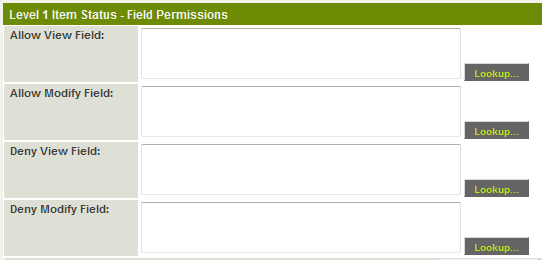Difference between revisions of "Role Field Permissions"
From SmartWiki
(→See Also) |
|||
| Line 16: | Line 16: | ||
==See Also== | ==See Also== | ||
| + | * [[Field Permissions]] | ||
* [[Batch Update Custom Field Settings]] | * [[Batch Update Custom Field Settings]] | ||
{{VisibilityofCustomFields}} | {{VisibilityofCustomFields}} | ||
Revision as of 12:42, 26 November 2013
Access to a standard or custom field is controlled by permissions.
- Allow View Field – If you associate this setting with Roles, then the field will only be displayed to people with these Roles. If you leave this field blank, then everyone will be able to see the field.
- Allow Modify Field – If you associate this setting with Roles, then the field will only be modifiable by people with these Roles. If you leave this field blank, then everyone will be able to modify the value on the field.
- Deny View Field – If you associate this setting with Roles, then the field will not be displayed to people with these Roles. If you leave this field blank, then everyone will be able to see the field.
- Deny Modify Field – If you associate this setting with Roles, then the field will not be modifiable by people with these Roles. If you leave this field blank, then everyone will be able to modify the value on the field.
- These permissions are used in conjunction with the Status Field Permissions. You must be in a given role to see a field AND the field needs to be visible at that status.
- If no UTA status field permissions are set, the fields are only controlled through the status permissions and the field's Visibility Conditions.
- This feature is available for custom fields at Level 1, Level 2 and Level 3 in a .
- This feature is also available for standard fields in a UTA.
- For fields that do not store data (for example, the Browser Script or Display Only – Image field types, the "Modify Field" Permission options are not available. You can still set the Allow View Field and Deny View Field permissions for these fields.
See Also
Visibility of Custom Fields can also be controlled using:
- Role Field Permissions
- Status Field Permissions
- Type Field Permissions
- Field Permission Matrix
- Show/Hide Header
